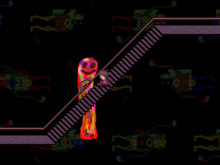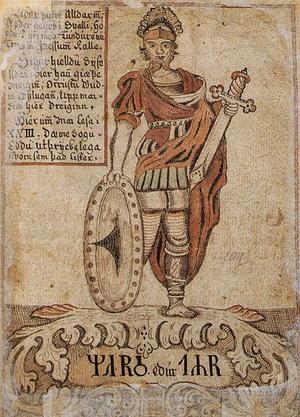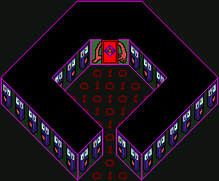>Mt.kiki No edit summary |
mNo edit summary |
||
| (23 intermediate revisions by 5 users not shown) | |||
| Line 23: | Line 23: | ||
<br><br><br> | |||
=='''''1. [[Yume Nikki:Number World#The Stairway|The Stairway]]'''''== | |||
<br> | |||
[[File:Kyukyu.png|thumb|300px|A red brat, a yellow beast, the blue favorable realms of bellicose spirits.<br />If these 3 colors are mixed, it will be said that it becomes infernal black.]] | |||
=The Stairway([http://en.wikipedia.org/wiki/Diyu Diyu])= | |||
---- | |||
==[[ | |||
[http://ja.wikipedia.org/wiki/%E5%9C%B0%E7%8D%84_(%E4%BB%8F%E6%95%99)#.E6.A6.82.E8.AA.AC <u>1 概説</u>] [http://ja.wikipedia.org/wiki/%E5%9C%B0%E7%8D%84_(%E4%BB%8F%E6%95%99)#.E5.9C.B0.E7.8D.84.E3.81.AE.E8.89.B2 <u>1.1 地獄の色</u>] (1 Outline 1.1 An infernal color) | [http://ja.wikipedia.org/wiki/%E5%9C%B0%E7%8D%84_(%E4%BB%8F%E6%95%99)#.E6.A6.82.E8.AA.AC <u>1 概説</u>] [http://ja.wikipedia.org/wiki/%E5%9C%B0%E7%8D%84_(%E4%BB%8F%E6%95%99)#.E5.9C.B0.E7.8D.84.E3.81.AE.E8.89.B2 <u>1.1 地獄の色</u>] (1 Outline 1.1 An infernal color) | ||
| Line 39: | Line 35: | ||
At the Buddhism of East Asia, an infernal color is expressed with "black" to a Taoism target or the Yin Yang philosophy target which was subject to the influence. | At the Buddhism of East Asia, an infernal color is expressed with "black" to a Taoism target or the Yin Yang philosophy target which was subject to the influence. | ||
[[File:Paracas-textiles3.jpg|thumb|171px|Detail of one shaman showing knife and head]] | |||
餓鬼は[http://ja.wikipedia.org/wiki/%E8%B5%A4 <u>赤</u>]、畜生は[http://ja.wikipedia.org/wiki/%E9%BB%84%E8%89%B2 <u>黄</u>]、修羅は[http://ja.wikipedia.org/wiki/%E9%9D%92 <u>青</u>]、この三色を混ぜると地獄の黒になると言われる。 | 餓鬼は[http://ja.wikipedia.org/wiki/%E8%B5%A4 <u>赤</u>]、畜生は[http://ja.wikipedia.org/wiki/%E9%BB%84%E8%89%B2 <u>黄</u>]、修羅は[http://ja.wikipedia.org/wiki/%E9%9D%92 <u>青</u>]、この三色を混ぜると地獄の黒になると言われる。 | ||
| Line 46: | Line 44: | ||
また、[http://ja.wikipedia.org/wiki/%E7%AF%80%E5%88%86 <u>節分</u>]で追われる赤鬼、黄鬼、青鬼はここから来ている。 | また、[http://ja.wikipedia.org/wiki/%E7%AF%80%E5%88%86 <u>節分</u>]で追われる赤鬼、黄鬼、青鬼はここから来ている。 | ||
Moreover, the red devil, yellow devil, and the blue devil who are ousted on the eve of the beginning of spring are coming from here. | Moreover, the red devil, yellow devil, and the blue devil who are ousted on the eve of the beginning of spring are coming from here.<br> | ||
==☀Notes== | |||
<br>※Back ground image(the red devil, yellow devil, and the blue devil ) in The Stairway([http://en.wikipedia.org/wiki/Diyu Diyu]) | |||
Diyu ([http://en.wikipedia.org/wiki/Sanskrit <u>Sanskrit</u>]: नरक "[http://en.wikipedia.org/wiki/Naraka <u>Naraka</u>]") is the realm of the dead or "[http://en.wikipedia.org/wiki/Hell <u>hell</u>]" in [http://en.wikipedia.org/wiki/Chinese_mythology <u>Chinese mythology</u>]. | The Stairway([http://en.wikipedia.org/wiki/Diyu Diyu]) ⇒ Diyu ([http://en.wikipedia.org/wiki/Sanskrit <u>Sanskrit</u>]: नरक "[http://en.wikipedia.org/wiki/Naraka <u>Naraka</u>]") is the realm of the dead or "[http://en.wikipedia.org/wiki/Hell <u>hell</u>]" in [http://en.wikipedia.org/wiki/Chinese_mythology <u>Chinese mythology</u>] ⇒ [http://yumenikki.wikia.com/wiki/Number_World(name)#The_Bed_Room.28Naraka_.28Buddhism.29.29 11 The Bed Room(Naraka (Buddhism))] <br> | ||
<br><br><br> | |||
[[File:Kyukyu.png|thumb|300px|KyuuKyuu-kun(baluster)]] | |||
=='''''2. [[Yume Nikki:KyuuKyuu-kun|KyuuKyuu-kun]]'''''== | |||
<br> | |||
=KyuuKyuu-kun([http://en.wikipedia.org/wiki/Baluster Baluster])= | |||
---- | |||
[[File:Balustrade in San Zeno, Verona.JPG|thumb|220x220px|Stone balusters in the Basilica of San Zeno, Verona]] | |||
A baluster — also called spindle or stair stick — is a moulded shaft, square or of [http://en.wikipedia.org/wiki/Lathe <u>lathe</u>]-turned form, one of various forms of [http://en.wikipedia.org/wiki/Spindle_(furniture) <u>spindle in woodwork</u>], made of stone or wood and sometimes of metal,<sup class="reference" id="cite_ref-1">[http://en.wikipedia.org/wiki/Baluster#cite_note-1 <u>[1</u>]]</sup> standing on a unifying footing, and supporting the [http://en.wikipedia.org/wiki/Coping_(architecture) <u>coping</u>] of a [http://en.wikipedia.org/wiki/Parapet <u>parapet</u>] or the [http://en.wikipedia.org/wiki/Handrail <u>handrail</u>] of a [http://en.wikipedia.org/wiki/Stairway <u>staircase</u>]. Multiplied in this way, they form a balustrade.<sup class="reference" id="cite_ref-2">[http://en.wikipedia.org/wiki/Baluster#cite_note-2 <u>[2</u>]]</sup> Individually, a baluster shaft may describe the turned form taken by a brass or silver candlestick, an upright furniture support, or the stem of a brass chandelier, etc. | |||
手すり子またはバラスター([https://en.wikipedia.org/wiki/Baluster baluster])は、共通の基礎の上に立ち、[http://ja.wikipedia.org/wiki/%E9%9A%8E%E6%AE%B5 <u>階段</u>]などの[http://ja.wikipedia.org/wiki/%E6%89%8B%E6%91%BA <u>手すり</u>]や[http://ja.wikipedia.org/wiki/%E6%AC%84%E5%B9%B2 <u>欄干</u>]の笠木(手でつかむ横板状の部分)を支持する柱状の装飾的構造で、角柱、円柱、[http://ja.wikipedia.org/wiki/%E5%9B%9E%E8%BB%A2%E4%BD%93 <u>回転体</u>]などの形状があり、石や木材、時には金属でできている<sup class="reference" id="cite_ref-0">[http://ja.wikipedia.org/wiki/%E6%89%8B%E3%81%99%E3%82%8A%E5%AD%90#cite_note-0 <u>[1</u>]]</sup>。 | |||
[[File:KyuuKyuu-kun.png|thumb|103px|KyuuKyuu-kun looks Pomegranate color.]]<br> | |||
[[File: | =KyuuKyuu-kun([https://en.wikipedia.org/wiki/Pomegranate Pomegranate])= | ||
----[[File:Illustration_Punica_granatum.jpg|thumb|left|Swelling form of the half-open flower of ''Punica granatum''|123x123px]] | |||
[ | The '''[https://en.wikipedia.org/wiki/Pomegranate pomegranate]''' (''Punica granatum'') is a fruit-bearing deciduous shrub or small tree in the family Lythraceae that grows between 5 and 8 m (16 and 26 ft) tall. | ||
'''手すり子'''または'''バラスター'''(baluster)は、共通の基礎の上に立ち、階段などの手すりや欄干の笠木(手でつかむ横板状の部分)を支持する柱状の装飾的構造で、角柱、円柱、回転体などの形状があり、石や木材、時には金属でできている<sup>[https://ja.wikipedia.org/wiki/%E6%89%8B%E3%81%99%E3%82%8A%E5%AD%90#cite_note-1 <nowiki>[1]</nowiki>]</sup>。 | |||
[[File:Baluster_(PSF).png|thumb|49px|Baluster|left]]According to ''[https://en.wikipedia.org/wiki/OED OED]'', "[http://en.wikipedia.org/wiki/Baluster baluster]" is derived through the [https://en.wikipedia.org/wiki/French_language French]: ''balustre'', from [https://en.wikipedia.org/wiki/Italian_language Italian]: ''balaustro'', from ''balaustra'', "pomegranate flower" [from a resemblance to the swelling form of the half-open flower (''illustration, below left'')],<sup>[https://en.wikipedia.org/wiki/Baluster#cite_note-4 <nowiki>[4]</nowiki>]</sup> from [https://en.wikipedia.org/wiki/Latin Latin] ''balaustium'', from [https://en.wikipedia.org/wiki/Ancient_Greek_language Greek] βαλαύστιον (''balaustion''). | |||
"[http://en.wikipedia.org/wiki/Baluster baluster]" は[http://ja.wikipedia.org/wiki/%E3%82%AA%E3%83%83%E3%82%AF%E3%82%B9%E3%83%95%E3%82%A9%E3%83%BC%E3%83%89%E8%8B%B1%E8%AA%9E%E8%BE%9E%E5%85%B8 <u>OED</u>]によると「石榴の花」を意味する balaustra に由来し、半分開きかけた蕾に形状が似ているためにそのように名付けられたという<sup class="reference" id="cite_ref-1">[http://ja.wikipedia.org/wiki/%E6%89%8B%E3%81%99%E3%82%8A%E5%AD%90#cite_note-1 <u>[2</u>]]</sup>。手すり子が複数並んだ欄干を英語では "balustrade" と呼ぶ<sup class="reference" id="cite_ref-2">[http://ja.wikipedia.org/wiki/%E6%89%8B%E3%81%99%E3%82%8A%E5%AD%90#cite_note-2 <u>[3</u>]]</sup>。 | |||
<br><br>[[File:Kamakura Kishimojin.jpg|thumb|356x356px|Kishimojin as a demon mistress with infant. 12th-13th century, Kamakura period. Daigo-ji, Kyoto, Japan.]] | |||
=KyuuKyuu-kun([https://en.wikipedia.org/wiki/Hariti Hariti])= | |||
---- | |||
According to myth, [https://en.wikipedia.org/wiki/Hariti Hārītī] was originally a rākṣasī of Rajgir at the same time that Gautama Buddha also lived there. She had hundreds of children of her own, whom she loved and doted upon, but to feed them, she abducted and killed the children of others. The bereaved mothers of her victims pleaded to the Buddha to save them. So, the Buddha stole the youngest of her sons (in a variant version, the youngest daughter), and hid him under his rice bowl. After having desperately searched for her missing son throughout the universe, [https://en.wikipedia.org/wiki/Hariti Hārītī] finally appealed to the Buddha for help. | |||
Azes coin in India, with Demeter/ Hariti with children and holding a cornucopia (Obv.)and Hermes (Rev.), 1st century BCE. | |||
The Buddha pointed out that she was suffering because she lost one of hundreds of children, and asked if she could imagine the suffering of parents whose only child had been devoured. She replied contritely that their suffering must be many times greater than hers. She then vowed to protect all children, and in lieu of children's flesh, she would henceforth only eat [https://en.wikipedia.org/wiki/Pomegranate pomegranates]. Henceforth [https://en.wikipedia.org/wiki/Hariti Hārītī] became the protector of children and women in childbirth. In exchange, the Buddha gave her bodhi, which enabled her to withstand black magic and evil powers, and gave her the facility to cure the sick.[https://en.wikipedia.org/wiki/Hariti#cite_note-2 <nowiki>[2]</nowiki>][https://en.wikipedia.org/wiki/Hariti#cite_note-Schumacher-1 <nowiki>[1]</nowiki>][[File:Yn char kyuu.png|thumb|she would henceforth only eat [https://en.wikipedia.org/wiki/Pomegranate pomegranates].]] | |||
==☀Notes== | |||
<br>※KyuuKyuu-kun([https://en.wikipedia.org/wiki/Pomegranate Pomegranate]) is the figure that revealed the mother([https://en.wikipedia.org/wiki/Hariti Hārītī]) of a child([[Yume Nikki:Madotsuki|Madotsuki]]) | |||
[[File:Kyukyu.png|thumb|220x220px]]<br> | |||
<br> | |||
=KyuuKyuu-kun([http://en.wikipedia.org/wiki/T%C3%BDr Týr])= | |||
< | |||
---- | ---- | ||
[http://ja.wikipedia.org/wiki/%E9%9A%BB%E8%85%95#.E7.A5.9E.E8.A9.B1.E3.83.BB.E4.BC.9D.E6.89.BF <u>4 神話・伝承</u>] (One-Hand in the legend, myth) | |||
[[File:IB_299_4to_Tyr.jpg|thumb|18世紀のアイスランドの写本『ÍB 299 4to』に描かれたテュール。]] | [[File:IB_299_4to_Tyr.jpg|thumb|18世紀のアイスランドの写本『ÍB 299 4to』に描かれたテュール。]] | ||
時代、地方によれば「身体障害者には不思議な力が宿る」とされたこともあり、[http://ja.wikipedia.org/wiki/%E9%9A%BB%E7%9C%BC <u>隻眼</u>]の神などがいるがあまり四肢の欠損した神などが登場することは少ない。しかし、腕の喪失はなんらかの力の喪失として語られることがある。腕とともに力を失った例として、[http://ja.wikipedia.org/wiki/%E5%8C%97%E6%AC%A7%E7%A5%9E%E8%A9%B1 <u>北欧神話</u>]の[http://ja.wikipedia.org/wiki/%E3%83%86%E3%83%A5%E3%83%BC%E3%83%AB <u>テュール</u>]がいる。伝承によれば、神々の間ではテュールの右手にかけて約束をする習慣があったというが、彼の右腕喪失とともに約束を守るという拘束力が弱まったというのである。 | 時代、地方によれば「身体障害者には不思議な力が宿る」とされたこともあり、[http://ja.wikipedia.org/wiki/%E9%9A%BB%E7%9C%BC <u>隻眼</u>]の神などがいるがあまり四肢の欠損した神などが登場することは少ない。しかし、腕の喪失はなんらかの力の喪失として語られることがある。腕とともに力を失った例として、[http://ja.wikipedia.org/wiki/%E5%8C%97%E6%AC%A7%E7%A5%9E%E8%A9%B1 <u>北欧神話</u>]の[http://ja.wikipedia.org/wiki/%E3%83%86%E3%83%A5%E3%83%BC%E3%83%AB <u>テュール</u>]がいる。伝承によれば、神々の間ではテュールの右手にかけて約束をする習慣があったというが、彼の右腕喪失とともに約束を守るという拘束力が弱まったというのである。 | ||
Rarely, such as God, which is deficient in the extremities too appeared sometimes age was According "to persons with disabilities mysterious power dwells" and in a rural location, but there is such as God of | Rarely, such as God, which is deficient in the extremities too appeared sometimes age was According "to persons with disabilities mysterious power dwells" and in a rural location, but there is such as God of [https://en.wikipedia.org/wiki/List_of_one-eyed_creatures_in_mythology_and_fiction One-eyed]. However, you may be told as a loss of some loss of arm strength. As an example of the power lost with the arm, there are [http://en.wikipedia.org/wiki/T%C3%BDr Týr] of [https://en.wikipedia.org/wiki/Norse_mythology Norse mythology]. According to the tradition, but said there was a habit of his right hand toward the promise of [http://en.wikipedia.org/wiki/T%C3%BDr Týr] among the gods, a binding promise to protect the loss, along with his right arm is weakened by all means. | ||
- | [[File:Number World(Binary number).png|thumb|220x220px|Number World Door is One-armed]] | ||
==☀Notes== | |||
※[https://en.wikipedia.org/wiki/List_of_one-eyed_creatures_in_mythology_and_fiction One-eyed] and One-legged([[Yume Nikki:Mars-san|Mars-san]]) and One-armed(KyuuKyuu-kun) are associated with [https://en.wikipedia.org/wiki/List_of_one-eyed_creatures_in_mythology_and_fiction One-eyed], One-armed, One-legged door([[Yume Nikki:Number World|Number World]] Door) | |||
http://yumenikki.wikia.com/wiki/Number_World(name)#Number_World.28The_Evil_Eye_Door.29<br><br> | |||
<br><br><br> | |||
http://yumenikki.wikia.com/wiki/Number_World(name)#Number_World.28The_Evil_Eye_Door.29 | =='''''3. Mars-san'''''== | ||
==[[Mars-san]]([http://en.wikipedia.org/wiki/T%C3%BDr Týr]) | <br> | ||
<br>[[File:Mars-san.gif|thumb|Mars-san([https://en.wikipedia.org/wiki/Tuesday Tiw] was equated with <u>[http://en.wikipedia.org/wiki/Mars_(mythology) Mars]</u>)]] | |||
=Mars-san([http://en.wikipedia.org/wiki/T%C3%BDr Týr])= | |||
[http://ja.wikipedia.org/wiki/%E3%83%86%E3%83%A5%E3%83%BC%E3%83%AB#.E8.A7.A3.E8.AA.AC <u>1 解説</u>] | ----[http://ja.wikipedia.org/wiki/%E3%83%86%E3%83%A5%E3%83%BC%E3%83%AB#.E8.A7.A3.E8.AA.AC <u>1 解説</u>] | ||
テュールが最高神であった時代のゲルマン人諸族の王を意味する語は、ティワズの祭司を意味するティウダンス (thiudans) であった。 絵画などでは隻腕の戦士の姿で表され、これは[http://ja.wikipedia.org/wiki/%E3%83%95%E3%82%A7%E3%83%B3%E3%83%AA%E3%83%AB <u>フェンリル</u>]に片手を食いちぎられたことを示す。 またルーン文字のティールは軍神テュールの象徴で勝利を意味する。戦いの際にこのルーンを剣に刻み勝利を祈ったとされる。 | テュールが最高神であった時代のゲルマン人諸族の王を意味する語は、ティワズの祭司を意味するティウダンス (thiudans) であった。 絵画などでは隻腕の戦士の姿で表され、これは[http://ja.wikipedia.org/wiki/%E3%83%95%E3%82%A7%E3%83%B3%E3%83%AA%E3%83%AB <u>フェンリル</u>]に片手を食いちぎられたことを示す。 またルーン文字のティールは軍神テュールの象徴で勝利を意味する。戦いの際にこのルーンを剣に刻み勝利を祈ったとされる。 | ||
軍神という点で[http://ja.wikipedia.org/wiki/%E3%83%AD%E3%83%BC%E3%83%9E%E7%A5%9E%E8%A9%B1 <u>ローマ神話</u>]の軍神[http://ja.wikipedia.org/wiki/%E3%83%9E%E3%83%BC%E3%83%AB%E3%82%B9 <u>マールス</u>]と同一視され、ゲルマン語で[http://ja.wikipedia.org/wiki/%E7%81%AB%E6%9B%9C%E6%97%A5 <u>火曜日</u>]を意味する語 (Tuesday など) の語源となった。 | 軍神という点で[http://ja.wikipedia.org/wiki/%E3%83%AD%E3%83%BC%E3%83%9E%E7%A5%9E%E8%A9%B1 <u>ローマ神話</u>]の軍神[http://ja.wikipedia.org/wiki/%E3%83%9E%E3%83%BC%E3%83%AB%E3%82%B9 <u>マールス</u>]と同一視され、ゲルマン語で[http://ja.wikipedia.org/wiki/%E7%81%AB%E6%9B%9C%E6%97%A5 <u>火曜日</u>]を意味する語 (Tuesday など) の語源となった。 | ||
Týr (pron.: [http://en.wikipedia.org/wiki/Help:IPA_for_English <u>/</u>][http://en.wikipedia.org/wiki/Help:IPA_for_English#Key <span style="border-bottom-color: currentColor; border-bottom-width: 1px; border-bottom-style: dotted;" title="/ˈ/ primary stress follows"><u>ˈ</u></span>][http://en.wikipedia.org/wiki/Help:IPA_for_English#Key <span style="border-bottom-color: currentColor; border-bottom-width: 1px; border-bottom-style: dotted;" title="'t' in 'tie'"><u>t</u></span>][http://en.wikipedia.org/wiki/Help:IPA_for_English#Key <span style="border-bottom-color: currentColor; border-bottom-width: 1px; border-bottom-style: dotted;" title="/ɪər/ 'ear' in 'beard'"><u>ɪər</u></span>][http://en.wikipedia.org/wiki/Help:IPA_for_English <u>/</u>];<sup class="reference" id="cite_ref-1">[http://en.wikipedia.org/wiki/T%C3%BDr#cite_note-1 <u>[1</u>]]</sup> [http://en.wikipedia.org/wiki/Old_Norse <u>Old Norse</u>]: Týr [http://en.wikipedia.org/wiki/Help:IPA_for_Swedish_and_Norwegian <u>[tyːr</u>]]) is the god of [http://en.wikipedia.org/wiki/Law <u>Law</u>], the [http://en.wikipedia.org/wiki/Althing <u>althing</u>], Justice, The Sky, and heroic glory in [http://en.wikipedia.org/wiki/Norse_mythology <u>Norse mythology</u>], portrayed as a one-handed man. Corresponding names in other Germanic languages are [http://en.wikipedia.org/wiki/Gothic_language <u>Gothic</u>] Teiws, [http://en.wikipedia.org/wiki/Old_English_language <u>Old English</u>] Tīw and [http://en.wikipedia.org/wiki/Old_High_German <u>Old High German</u>] Ziu and Cyo, all from [http://en.wikipedia.org/wiki/Proto-Germanic <u>Proto-Germanic</u>] *Tîwaz (*Tē₂waz). The [http://en.wikipedia.org/wiki/Latin_language <u>Latinised</u>] name is Tius or Tio.<sup class="reference" id="cite_ref-2">[http://en.wikipedia.org/wiki/T%C3%BDr#cite_note-2 <u>[2</u>]]</sup> | Týr (pron.: [http://en.wikipedia.org/wiki/Help:IPA_for_English <u>/</u>][http://en.wikipedia.org/wiki/Help:IPA_for_English#Key <span style="border-bottom-color: currentColor; border-bottom-width: 1px; border-bottom-style: dotted;" title="/ˈ/ primary stress follows"><u>ˈ</u></span>][http://en.wikipedia.org/wiki/Help:IPA_for_English#Key <span style="border-bottom-color: currentColor; border-bottom-width: 1px; border-bottom-style: dotted;" title="'t' in 'tie'"><u>t</u></span>][http://en.wikipedia.org/wiki/Help:IPA_for_English#Key <span style="border-bottom-color: currentColor; border-bottom-width: 1px; border-bottom-style: dotted;" title="/ɪər/ 'ear' in 'beard'"><u>ɪər</u></span>][http://en.wikipedia.org/wiki/Help:IPA_for_English <u>/</u>];<sup class="reference" id="cite_ref-1">[http://en.wikipedia.org/wiki/T%C3%BDr#cite_note-1 <u>[1</u>]]</sup> [http://en.wikipedia.org/wiki/Old_Norse <u>Old Norse</u>]: Týr [http://en.wikipedia.org/wiki/Help:IPA_for_Swedish_and_Norwegian <u>[tyːr</u>]]) is the god of [http://en.wikipedia.org/wiki/Law <u>Law</u>], the [http://en.wikipedia.org/wiki/Althing <u>althing</u>], Justice, The Sky, and heroic glory in [http://en.wikipedia.org/wiki/Norse_mythology <u>Norse mythology</u>], portrayed as a one-handed man. Corresponding names in other Germanic languages are [http://en.wikipedia.org/wiki/Gothic_language <u>Gothic</u>] Teiws, [http://en.wikipedia.org/wiki/Old_English_language <u>Old English</u>] Tīw and [http://en.wikipedia.org/wiki/Old_High_German <u>Old High German</u>] Ziu and Cyo, all from [http://en.wikipedia.org/wiki/Proto-Germanic <u>Proto-Germanic</u>] *Tîwaz (*Tē₂waz). The [http://en.wikipedia.org/wiki/Latin_language <u>Latinised</u>] name is Tius or Tio.<sup class="reference" id="cite_ref-2">[http://en.wikipedia.org/wiki/T%C3%BDr#cite_note-2 <u>[2</u>]]</sup> | ||
Tiw was equated with [http://en.wikipedia.org/wiki/Mars_(mythology) <u>Mars</u>] in the [http://en.wikipedia.org/wiki/Interpretatio_germanica <u>interpretatio germanica</u>]. [http://en.wikipedia.org/wiki/Tuesday <u>Tuesday</u>] is in fact "Tīw's Day" (also in [http://en.wikipedia.org/wiki/Alemannic_German <u>Alemannic</u>] Zischtig from zîes tag), translating dies Martis. | [https://en.wikipedia.org/wiki/Tuesday Tiw] was equated with [http://en.wikipedia.org/wiki/Mars_(mythology) <u>Mars</u>] in the [http://en.wikipedia.org/wiki/Interpretatio_germanica <u>interpretatio germanica</u>]. [http://en.wikipedia.org/wiki/Tuesday <u>Tuesday</u>] is in fact "[https://en.wikipedia.org/wiki/Tuesday Tīw's Day]" (also in [http://en.wikipedia.org/wiki/Alemannic_German <u>Alemannic</u>] Zischtig from zîes tag), translating dies Martis. | ||
[[File:Yn card numb t.png|thumb|220x220px]] | |||
==☀Notes== | |||
[[File:Number World(Binary number).png|thumb|220x220px]] | |||
Mars- | ※[https://en.wikipedia.org/wiki/List_of_one-eyed_creatures_in_mythology_and_fiction One-eyed] and One-legged(Mars-san) and One-armed(KyuuKyuu-kun) are associated with [https://en.wikipedia.org/wiki/List_of_one-eyed_creatures_in_mythology_and_fiction One-eyed], One-armed, One-legged door(Number World Door) | ||
http://yumenikki.wikia.com/wiki/Mars(name)#Mars-San.28Nicole.27s_Leg.29 | http://yumenikki.wikia.com/wiki/Mars(name)#Mars-San.28Nicole.27s_Leg.29 | ||
[[Category:Yume Nikki theoretical discussions by Mt.kiki]] | |||
Latest revision as of 03:08, 24 April 2023
1. The Stairway
The Stairway(Diyu)
1 概説 1.1 地獄の色 (1 Outline 1.1 An infernal color)
東アジアの仏教では、地獄の色は道教的に、あるいはその影響を受けた陰陽道的に「黒」で表す。
At the Buddhism of East Asia, an infernal color is expressed with "black" to a Taoism target or the Yin Yang philosophy target which was subject to the influence.
餓鬼は赤、畜生は黄、修羅は青、この三色を混ぜると地獄の黒になると言われる。
A red brat, a yellow beast, the blue favorable realms of bellicose spirits.
If these 3 colors are mixed, it will be said that it becomes infernal black.
また、節分で追われる赤鬼、黄鬼、青鬼はここから来ている。
Moreover, the red devil, yellow devil, and the blue devil who are ousted on the eve of the beginning of spring are coming from here.
☀Notes
※Back ground image(the red devil, yellow devil, and the blue devil ) in The Stairway(Diyu)
The Stairway(Diyu) ⇒ Diyu (Sanskrit: नरक "Naraka") is the realm of the dead or "hell" in Chinese mythology ⇒ 11 The Bed Room(Naraka (Buddhism))
2. KyuuKyuu-kun
KyuuKyuu-kun(Baluster)
A baluster — also called spindle or stair stick — is a moulded shaft, square or of lathe-turned form, one of various forms of spindle in woodwork, made of stone or wood and sometimes of metal,[1] standing on a unifying footing, and supporting the coping of a parapet or the handrail of a staircase. Multiplied in this way, they form a balustrade.[2] Individually, a baluster shaft may describe the turned form taken by a brass or silver candlestick, an upright furniture support, or the stem of a brass chandelier, etc.
手すり子またはバラスター(baluster)は、共通の基礎の上に立ち、階段などの手すりや欄干の笠木(手でつかむ横板状の部分)を支持する柱状の装飾的構造で、角柱、円柱、回転体などの形状があり、石や木材、時には金属でできている[1]。
KyuuKyuu-kun(Pomegranate)
The pomegranate (Punica granatum) is a fruit-bearing deciduous shrub or small tree in the family Lythraceae that grows between 5 and 8 m (16 and 26 ft) tall.
手すり子またはバラスター(baluster)は、共通の基礎の上に立ち、階段などの手すりや欄干の笠木(手でつかむ横板状の部分)を支持する柱状の装飾的構造で、角柱、円柱、回転体などの形状があり、石や木材、時には金属でできている[1]。
According to OED, "baluster" is derived through the French: balustre, from Italian: balaustro, from balaustra, "pomegranate flower" [from a resemblance to the swelling form of the half-open flower (illustration, below left)],[4] from Latin balaustium, from Greek βαλαύστιον (balaustion).
"baluster" はOEDによると「石榴の花」を意味する balaustra に由来し、半分開きかけた蕾に形状が似ているためにそのように名付けられたという[2]。手すり子が複数並んだ欄干を英語では "balustrade" と呼ぶ[3]。
KyuuKyuu-kun(Hariti)
According to myth, Hārītī was originally a rākṣasī of Rajgir at the same time that Gautama Buddha also lived there. She had hundreds of children of her own, whom she loved and doted upon, but to feed them, she abducted and killed the children of others. The bereaved mothers of her victims pleaded to the Buddha to save them. So, the Buddha stole the youngest of her sons (in a variant version, the youngest daughter), and hid him under his rice bowl. After having desperately searched for her missing son throughout the universe, Hārītī finally appealed to the Buddha for help.
Azes coin in India, with Demeter/ Hariti with children and holding a cornucopia (Obv.)and Hermes (Rev.), 1st century BCE.
The Buddha pointed out that she was suffering because she lost one of hundreds of children, and asked if she could imagine the suffering of parents whose only child had been devoured. She replied contritely that their suffering must be many times greater than hers. She then vowed to protect all children, and in lieu of children's flesh, she would henceforth only eat pomegranates. Henceforth Hārītī became the protector of children and women in childbirth. In exchange, the Buddha gave her bodhi, which enabled her to withstand black magic and evil powers, and gave her the facility to cure the sick.[2][1]

☀Notes
※KyuuKyuu-kun(Pomegranate) is the figure that revealed the mother(Hārītī) of a child(Madotsuki)
KyuuKyuu-kun(Týr)
4 神話・伝承 (One-Hand in the legend, myth)
時代、地方によれば「身体障害者には不思議な力が宿る」とされたこともあり、隻眼の神などがいるがあまり四肢の欠損した神などが登場することは少ない。しかし、腕の喪失はなんらかの力の喪失として語られることがある。腕とともに力を失った例として、北欧神話のテュールがいる。伝承によれば、神々の間ではテュールの右手にかけて約束をする習慣があったというが、彼の右腕喪失とともに約束を守るという拘束力が弱まったというのである。
Rarely, such as God, which is deficient in the extremities too appeared sometimes age was According "to persons with disabilities mysterious power dwells" and in a rural location, but there is such as God of One-eyed. However, you may be told as a loss of some loss of arm strength. As an example of the power lost with the arm, there are Týr of Norse mythology. According to the tradition, but said there was a habit of his right hand toward the promise of Týr among the gods, a binding promise to protect the loss, along with his right arm is weakened by all means.
☀Notes
※One-eyed and One-legged(Mars-san) and One-armed(KyuuKyuu-kun) are associated with One-eyed, One-armed, One-legged door(Number World Door)
http://yumenikki.wikia.com/wiki/Number_World(name)#Number_World.28The_Evil_Eye_Door.29
3. Mars-san
Mars-san(Týr)
テュールが最高神であった時代のゲルマン人諸族の王を意味する語は、ティワズの祭司を意味するティウダンス (thiudans) であった。 絵画などでは隻腕の戦士の姿で表され、これはフェンリルに片手を食いちぎられたことを示す。 またルーン文字のティールは軍神テュールの象徴で勝利を意味する。戦いの際にこのルーンを剣に刻み勝利を祈ったとされる。
軍神という点でローマ神話の軍神マールスと同一視され、ゲルマン語で火曜日を意味する語 (Tuesday など) の語源となった。
Týr (pron.: /ˈtɪər/;[1] Old Norse: Týr [tyːr]) is the god of Law, the althing, Justice, The Sky, and heroic glory in Norse mythology, portrayed as a one-handed man. Corresponding names in other Germanic languages are Gothic Teiws, Old English Tīw and Old High German Ziu and Cyo, all from Proto-Germanic *Tîwaz (*Tē₂waz). The Latinised name is Tius or Tio.[2]
Tiw was equated with Mars in the interpretatio germanica. Tuesday is in fact "Tīw's Day" (also in Alemannic Zischtig from zîes tag), translating dies Martis.
☀Notes
※One-eyed and One-legged(Mars-san) and One-armed(KyuuKyuu-kun) are associated with One-eyed, One-armed, One-legged door(Number World Door)
http://yumenikki.wikia.com/wiki/Mars(name)#Mars-San.28Nicole.27s_Leg.29












